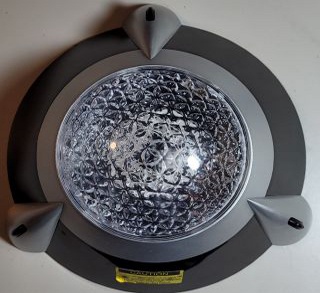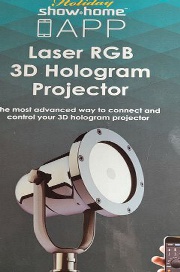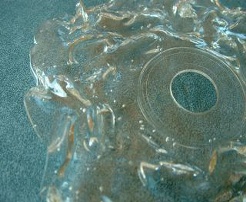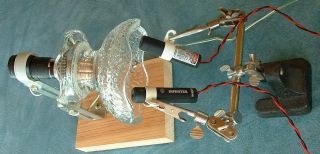|
|









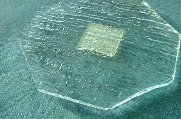




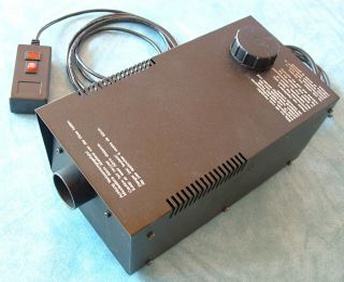
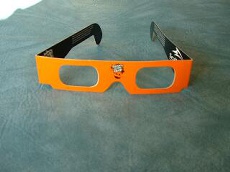
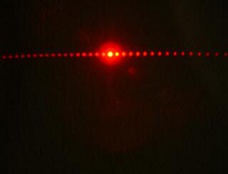
Special Effects
Some cool DIY effects that enhance the interest level of your laser beams
Here I'll show some of the things you can use to get some of the special effects you might see at a laser show or special event
that is using lasers for show. There are some surprisingly simple and very inexpensive items that can be used to obtain some
super cool laser lighting effects that I've used (and even created) myself. These are displayed below with some explanation of
how to make them or how to use them. But first I'll start off with a few items I purchased that bear mention... The one shown in
the 'OptykMuse' logo image above (and on the main page) and one more that's even cooler...
One safety note - because the laser can deflect at unpredictable angles it's advised to be familiar with the lumia you are using and know the limits of where the beam will go, or use a mask to prevent it from deflecting into your audience.
One safety note - because the laser can deflect at unpredictable angles it's advised to be familiar with the lumia you are using and know the limits of where the beam will go, or use a mask to prevent it from deflecting into your audience.
There used to be a really fun shop to go into that was in most malls
back in the 90's or early 2000's called Spencers Gifts. Remember
those? Well it was in one of those stores I found this really cool
device called the "Laser Gazer" which would project swirly images
(called "Lumia" in laser show terminology) using three low power red
lasers under a slowly spinning dome of rumply clear plastic. The
lasers could be individually pointed using the black thumbwheels.
the lasers would show through the rumply plastic above them which
performs a magical transformation on the beams that must be seen
as it's really difficult to explain. The image above shows a glimps of
how it looks for an instant, but the laser effect is constantly
changing for each of the three lasers. Just turn off the lights, turn on
the Laser Gazer (and some Pink Floyd - Dark Side of the Moon),
and be amazed! The most unfortunate thing is that these have not
been available (at least not that I've been able to find) for years.
Dispair not though, there is another even better one I discovered
more recently that should still be available that uses three different
colors!
For those who were ready to run out right away and get a Laser
Gazer, will check this one out instead... It's call the "Laser RGB
3D Hologram Projector" by Holiday Show Home. It's not really
projecting holograms, but like the Laser Gazer it will project the
most cool Lumia patterns on the wall or ceiling (wherever you
have it pointed). The farther away from the wall the projector is,
the larger the lumia image will be. There is a phone app that
operates the unit via bluetooth which allows on/off control of each
laser color, lumia motor speed, color fade type, and power on/off.
These might be in short supply lately but I've seen a number of
them on Ebay for a decent price. To the right is a photo of the box
and an example of the type of lumia display you can see with this
projector. I stopped the lumia motor for the photo but it's
constantly changing shapes/patterns/colors during normal
operation. The image is bright enough to be seen in a lit room but
is super awesome in a dark room! I like these so much I have two
of them. These can be layered also if you have more than one.
Here is an example of a homebrew lumia wheel which works just
like the rumpled dome on the Laser Gazer and the disk inside the
Holiday lumia projector. In its previous life it was a clear CD disk
from a package of blank CD's (they would put these clear ones on
the top and bottom of the stack to protect the blank CD's). To
make it what I needed it to be I used a propane torch (like they
have at Harbor Freight) and very slowly and CAREFULLY softened
the disk until it began to warp and shrink and continued around
the disk until it was rumpled all the way around, being careful not
to melt the center where it needs to be flat for mounting to a slow
gear motor, preferrably 1 RPM or less. If it's a DC motor the speed
can be further controlled using a variable power supply. The other
photos are wheels cut from shower glass or plastic ceiling light
sheets and these can be obtained free also from broken sections.
It you don't have a way to cut glass a glass shop could do your
cutting for a small fee.
Another method I've seen is to use smooth glass or plastic disks and rub clear silicon adhesive or clear epoxy around on it and let it cure. I've not yet tried this myself but if I do make another Lumia wheel this will be the first thing I try out.
Another method I've seen is to use smooth glass or plastic disks and rub clear silicon adhesive or clear epoxy around on it and let it cure. I've not yet tried this myself but if I do make another Lumia wheel this will be the first thing I try out.
Here is an example of a way to use a glass candy bowl I bet you
never though of... I was looking for things to shine my laser pointer
through when I first started looking into the lumia affect (years
ago) and spotted this candy bowl. My wife saw my excitement
and the cool way it affected the laser beam and decided to donate
it to the cause. I used a small 'third hand' clip holder from my
electronics tool box, a couple of P-clamps, a DC gear motor,
some velcro, and finally, the candy bowl to create my own
multi-laser lumia wheel. I used this arrangement for my first laser
show on a cold new year's eve in the late 90's. The lasers were
powered from the Laser Power Controller (Other Hardware page).
Here's a commercial type lumia projector - it has several laser
positions shining through several different types of lumia
arrangements. One uses two lumia wheels on separate motors
which can be rotated either direction for added effect, another like
it with only one lumia wheel. Two more positions use turntables to
spin found glassware like my wife's candy dish. You can see how
creative one can get and how a collection of glass dishes and
bottles might grow over time... I forsee many trips to the local
thrift shop on the hunt for rumpled glassware! :)
A similar lumia projector could be homebrewed just from looking at this picture. I have not yet done so but made a copy of the image just to add to my own ideas. This is actually a great way to expand your own compliment of laser show equipment - doing image searches to get ideas which might send your thinking in a new direction and a novel new effect.
A similar lumia projector could be homebrewed just from looking at this picture. I have not yet done so but made a copy of the image just to add to my own ideas. This is actually a great way to expand your own compliment of laser show equipment - doing image searches to get ideas which might send your thinking in a new direction and a novel new effect.
Here we have another form of special effect - FOG. The can is
the less expensive way of employing this effect if you don't plan
on using fog very often, or just want to illuminate the beam for a
short time for testing or just for fun. Similar cans are available
from Amazon. But if you want to fog up a room the unit to the
right is the way to go. This on is a 'fogger' and another form is
called a 'hazer'. The fogger uses "fog fluid" which is a heavier
liquid that produces larger droplets. The hazer produces much
finer droplets that hang in the air longer and are less visible than
fogger fog but have about the same effect on the laser beams.
The can is pretty much the same fog as from a fogger.Hazers are
generally more expensive than foggers so for the DIY laser
hobbyist the foggers are a less expensive way to go. Fog fluid
can be purchased by the gallon on Amazon. I've obtained two
foggers for myself. One disadvantage of them is that the fluid
pump can clog and stop working necessitation disassembly and
cleaning (another learning process). But I've done this a few
times and it's not really that difficult if you're mechanically
inclined.
This is about as cheap as an effect can get... this is a pair of
disposable 3D glasses from a movie theater. The interesting
thing about these is that if you shine a laser beam through it
the single beam turns into a fan of beams! And pretty much for
free, other than the price of the movie. If you just happen to
have one of these around go ahead and shine a laser through it
and see for yourself. You could even take the lenses out and
attach them to a motor and see what happens when you shine
a laser through it when it's spinning! Of course a bit of fog from
the can in the entry above would make it even more fun :)
Another effect is to use mirrors to bounce the laser beams
around a large space or a room. This effect requires some effort
though, as the mirrors have to somehow be mounted at the
reflection positions and manually aligned using a live beam (so
best to use a safe low power beam for that part of the process). I
don't have any photos of bounce mirrors but if you've been to any
concerts that use lasers you have probably seen beams being
bounced around using this method. Larger mirrors make the job
easier. The mirrors would also be "first surface" type mirrors
where the reflective surface is directly on the surface of the mirror
that the laser beam hits.
A cheap way to get mirrors for this is to find a few bad computer hard drives and take them apart. The disks in these drives have a great reflective surface that will work fine for hobby / low budget applications.
A cheap way to get mirrors for this is to find a few bad computer hard drives and take them apart. The disks in these drives have a great reflective surface that will work fine for hobby / low budget applications.






